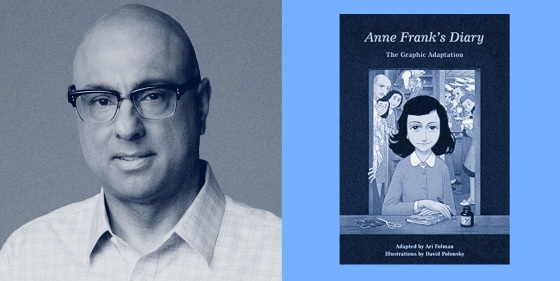On June 12, 1942, Anne Frank was given a red-and-white checkered journal for her 13th birthday. Over the next two years, she would go on to write hundreds of pages in that diary. Frank would write about fights with her mother, the ups and downs of adolescence and her first love. She would write about human nature and her identity as a young Jewish woman. She would write about the secret apartment her family, the Van Pels family and a man named Fritz Pfeffer were forced to live in as they tried to avoid being murdered by the Nazis.
The diary’s abrupt ending serves as a metaphor for Frank’s sudden death. She would die of typhus just weeks before Bergen-Belsen was liberated.
The last entry is dated Aug. 1, 1944, three days before Frank and the rest were discovered in that apartment and sent to concentration camps. The diary’s abrupt ending serves as a metaphor for Frank’s sudden death. She would die of typhus just weeks before Bergen-Belsen was liberated by the British in April 1945.
Velshi Banned Book Club members already know this story. “The Diary of Anne Frank” is not just one of the most widely disseminated accounts of Nazi occupation, it is also one of the most-read books of the 20th century. The Secret Annex has become a pilgrimage site for visitors to Amsterdam. Frank has been culturally canonized as the patron Saint of Adolescence. “The Diary” is a cultural and historical icon.
For generations of readers, Anne Frank’s words are a gateway: their first exposure to the dark depths of the Holocaust.
“The Diary of a Young Girl” or, as it is often called, “The Diary of Anne Frank,” is more than just an artifact of the Holocaust. It is a tender and intimate coming of age story. Eighty years later, Frank’s inner thoughts from ages 13, 14 and 15 still resonate. In that diary’s first entry she writes, “I hope I will be able to confide everything to you, as I have never been able to confide in anyone.” The reader becomes her confidant and in entry after entry bears witness to Frank’s growth and maturation. She begins to move toward more profound self-reflection and thought. She confronts humanity, struggles with her identity and reflects on changes to her body.
“The Diary of Anne Frank” is also a stirring account of prolonged trauma and a study in human psychology. The people in the Secret Annex endure torture: total seclusion and the constant threat of death, torture and imprisonment. They live with the sort of pressure that pushes the human spirit to the brink. And yet, Frank and the others hiding in the Annex display an unrelenting commitment to their values and their humanity. As Frank writes, “It’s a wonder I haven’t abandoned all my ideals, they seem so absurd and impractical. Yet I cling to them because I still believe, in spite of everything, that people are truly good at heart.” Understandably, this is the most quoted passage from her diary.
Is it any wonder that the “Diary” has inspired so many adaptations?
In 2018, Israeli artist David Polonsky and Israeli filmmaker Ari Folman, whose parents survived the Holocaust, worked together to reimagine the book. They called it “Anne Frank’s Diary: The Graphic Adaptation.” Their book uses both direct quotes from the diary and some original writing. Colorful and detailed illustrations fill any spaces left behind by the condensed text. When Frank and her older sister, Margo, hastily pack for the Secret Annex, Anne lists what she packs: “The first thing I stuck in was this diary, and then curlers, handkerchiefs, schoolbooks, a comb and some old letters.” The graphic version shows us her opened bag.
In the diary, Frank’s budding romance with Peter Van Pels in the Annex is thoroughly dissected page after page in a way that only a 14-year-old in love can do. In the graphic novel, their feelings are drawn. For example, Peter is reflected in the pupils of Anne’s eyes. This graphic adaptation masterfully maintains the integrity of the original Diary, particularly Frank’s humor and her emotional complexity, and modernizes it for today’s reader.
Is it any wonder that the “Diary” has inspired so many adaptations?
Despite all of this and all the accolades the graphic adaptation has received, an unidentified Texas teacher has been fired for assigning it to their 8th grade class. The given reason? The passages in which Frank describes her own body and thoughtfully considers her own sexuality.
When we chose this adaptation of Anne Frank’s story as a Velshi Banned Book Club feature, we discussed how much of the Texas teacher’s story we wanted to cover. We decided to focus more on the contents of the book, the power of the word, and what “Diary” represents. Why? Because it is exhausting and tedious to hear disingenuous words like “uncomfortable” or “pornographic” used to justify the attacks on such crucial and seismic literature.
Anne Frank’s diary depicts the Holocaust, which should make readers “uncomfortable”.
Anne Frank’s diary was written by a 13-year-old girl who at times writes about her own body. That is what this Texas school district views as pornographic? There is nothing pornographic about that.
There are conversations to be had about whether a book is appropriate or acceptable for a certain reading level. This is not one of those conversations. Preventing Anne Frank’s modern-day peers from reading her words and experiencing her story is deeply troubling. And, frankly, ridiculous.
This an adapted excerpt of the Sept. 23 episode of "Velshi."

